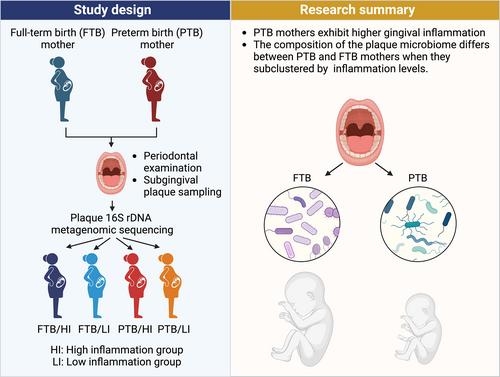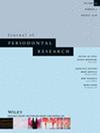Periodontitis is a potential risk factor for preterm birth (PTB) in women; however, the causal relationship or the exact mechanism remain unknown. This study aimed to compare the oral microbiome features of mothers with full-term birth (FTB) with those who had preterm delivery.
This study prospectively enrolled 60 women (30 mothers with PTB and 30 mothers with FTB), and subgingival plaque samples were collected and analysed by metagenomic 16S rDNA sequencing. Clinical measurements, including periodontal probing depth, clinical attachment level, modified gingival index (mGI) and plaque index, were performed to determine the periodontal state of the participants. Medical and obstetric data were collected as well.
Among the periodontal measurements, mGI score, reflecting the level of gingival inflammation, exhibited a statistically significant association with PTB (adjusted odds ratio 2.705, 95% confidence interval 1.074–6.811, p = .035). When subgroup analysis was conducted based on mean mGI scores (mGI ≥ 2, high inflammation [HI] versus mGI < 2, low inflammation [LI]), microbiome analysis revealed clear distinctions in microbial compositions between PTB and FTB mothers in both the HI and LI groups. Especially in the HI group, alpha diversity exhibited a decreasing trend in PTB mothers compared to FTB mothers. Beta diversity also revealed significant differences between the two groups. In Linear Discriminant Analysis Effect Size analysis, certain anaerobic taxa, including the genera Spirochaetes, Treponema and Porphyromonas, were relatively abundant in the FTB/HI group, whereas the PTB/HI group showed a high abundance of the order Actinomycetales. Network analysis showed that the FTB/HI had relatively stronger connectivity in microbial composition than the PTB/HI group. Dysbiosis ratio of plaque microbiome, in terms of periodontitis, was significantly lower in PTB/HI group compared to FTB/HI group.
The compositions of maternal subgingival microbiomes differed between PTB and FTB mothers in both the high and low levels of gingival inflammation groups. In the presence of high level of gingival inflammation, dysbiosis in plaque microbiome, in terms of periodontitis, was decreased in PTB mothers compared to FTB mothers.



